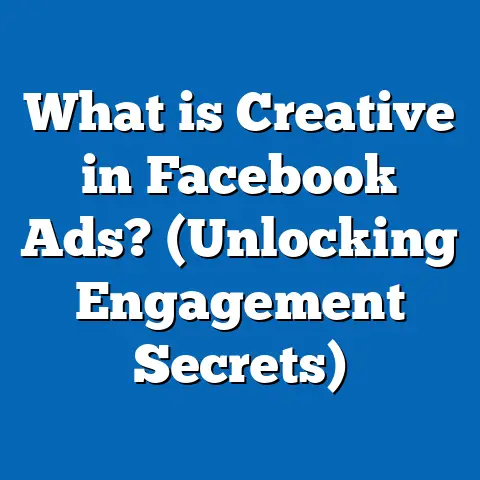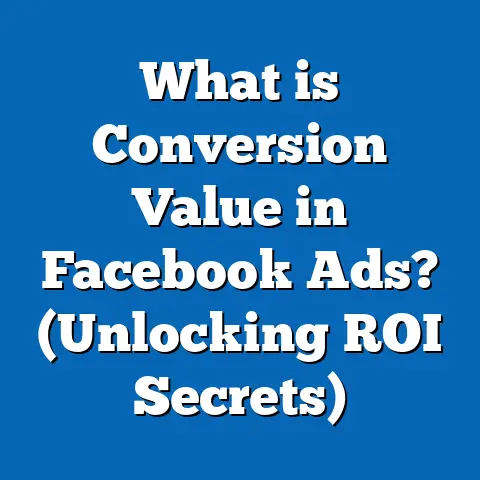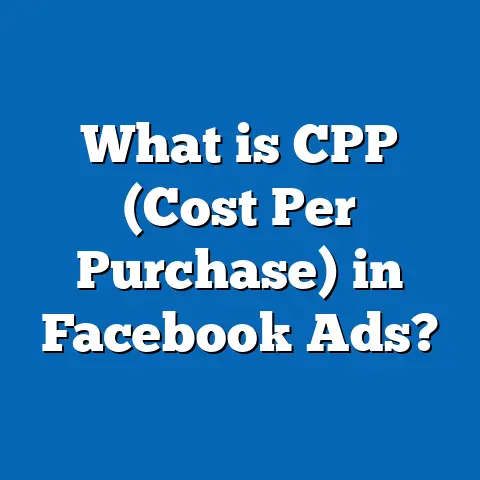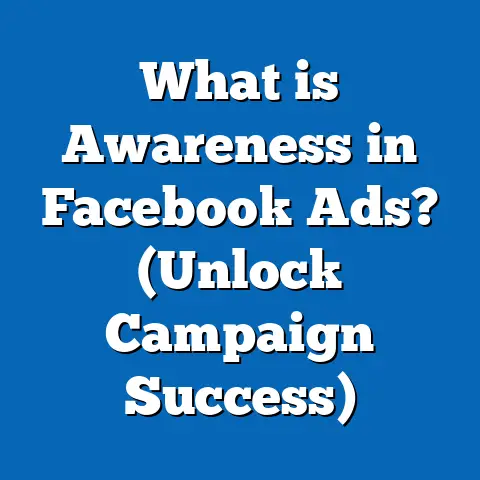What Is Facebook Ads Result Rate? (Unlocking Your Campaign Success)
Introduction: The Challenge of Measuring Facebook Ads Success
Running Facebook ads is a popular strategy for businesses aiming to reach targeted audiences, generate leads, and drive sales. However, many advertisers face a frustrating challenge: despite investing time and money, they struggle to understand whether their campaigns are truly effective. Without clear insight into how well your ads perform, you risk wasting budget on underperforming creatives or audiences.
The key to unlocking campaign success lies in understanding your Facebook Ads Result Rate — a critical metric that shows how effectively your ad delivers the desired outcome. This guide will walk you through everything you need to know about result rate: what it is, why it matters, how to calculate it, and most importantly, how to improve it.
By the end of this content, you will be equipped with actionable strategies backed by data and real-world examples to maximize your Facebook advertising results.
What Is Facebook Ads Result Rate?
Definition and Core Concept
Facebook Ads Result Rate is fundamentally a measure of efficiency. It quantifies how many desired actions (results) your ad achieves relative to the number of people who saw or interacted with it. The “result” depends on your campaign’s objective — whether it’s clicks, conversions, leads, or video views.
In mathematical terms: Result Rate=Number of Desired ResultsNumber of Impressions or Interactions×100%\text{Result Rate} = \frac{\text{Number of Desired Results}}{\text{Number of Impressions or Interactions}} \times 100\%
For example, if 1,000 people view your ad (impressions) and 50 people take the intended action (like making a purchase), your result rate is 5%.
Why Result Rate Is a Key Metric
- Performance Indicator: It tells you how compelling and relevant your ad is to the audience.
- Budget Efficiency: Helps determine if your ad spend is generating worthwhile outcomes.
- Optimization Guide: Offers insight into which ads or audiences need tweaking.
- ROI Predictor: Provides a clearer picture of return on investment beyond just clicks or impressions.
Without tracking this rate, advertisers often rely on vanity metrics like total impressions or clicks that don’t necessarily translate into business value.
Facebook Campaign Objectives and Their Role in Result Rate
Facebook offers a wide range of campaign objectives that define what counts as a “result.” Choosing the right objective influences both the way you measure success and how Facebook’s algorithm optimizes your ad delivery.
Breakdown of Common Campaign Objectives
| Objective | Description | Typical Result Measured |
|---|---|---|
| Brand Awareness | Increase overall awareness of your brand. | Impressions with estimated recall |
| Reach | Show your ad to as many people as possible. | Number of unique users reached |
| Traffic | Drive people to your website or app. | Link clicks |
| Engagement | Boost likes, comments, shares, event responses. | Post engagements |
| App Installs | Encourage app downloads. | Number of installs |
| Video Views | Get more views on videos. | Video views (3 seconds, 10 seconds) |
| Lead Generation | Collect contact information from users. | Leads submitted via forms |
| Conversions | Drive specific actions like purchases. | Purchases, sign-ups, add-to-cart events |
| Store Traffic | Drive visits to physical locations. | Store visits tracked via location data |
How Objectives Shape Result Rate
Each objective has its own definition of “result.” For example:
- In a Traffic campaign, a result might be a link click.
- In a Conversions campaign, a result is a completed purchase.
Understanding this distinction is crucial because result rates vary widely depending on the type of outcome measured.
How to Calculate Facebook Ads Result Rate
Step 1: Define What Counts as a Result
Before calculating the result rate, clarify what “result” means for your campaign. This depends on your objective.
Step 2: Select the Denominator — Impressions or Interactions?
- Impressions-based result rate: Number of results divided by total impressions.
- Click-based result rate: Number of results divided by total clicks (used mainly when optimizing for conversions).
Step 3: Use the Formula
Result Rate (%)=Number of ResultsNumber of Impressions×100\text{Result Rate (\%)} = \frac{\text{Number of Results}}{\text{Number of Impressions}} \times 100
Example: If an ad received 10,000 impressions and generated 300 leads: Result Rate=30010000×100=3%\text{Result Rate} = \frac{300}{10000} \times 100 = 3\%
Step 4: Analyze Cost Efficiency
To understand financial efficiency: Cost per Result=Total SpendNumber of Results\text{Cost per Result} = \frac{\text{Total Spend}}{\text{Number of Results}}
For example, if you spent $600 for those 300 leads: CPR=600300=2 USD per leadCPR = \frac{600}{300} = 2 \text{ USD per lead}
Why Both Metrics Matter
- Result rate (%) indicates effectiveness.
- Cost per result ($) shows efficiency.
Together, they give a full picture of campaign health.
Industry Benchmarks: What Is a Good Facebook Ads Result Rate?
Knowing industry standards helps you set realistic expectations and identify where your campaigns stand.
Average Benchmarks (2024 Data)
| Industry | Average CTR (%) | Average Conversion Rate (%) | Average Cost per Click (CPC) | Average Cost per Conversion |
|---|---|---|---|---|
| Retail & E-commerce | 1.59 | 9.21 | $0.70 | $10-$25 |
| Finance & Insurance | 0.56 | 6.72 | $3.77 | $45-$100 |
| B2B | 0.78 | 5.08 | $3.33 | $75+ |
| Education | 0.73 | 3.23 | $1.06 | $20-$50 |
| Healthcare | 0.83 | 4.43 | $1.32 | $30-$60 |
Source: WordStream Facebook Ads Benchmarks Report 2024
Insights from Benchmarks
- Retail campaigns tend to have higher conversion rates due to direct purchase intent.
- B2B campaigns often have higher costs due to niche targeting and longer sales cycles.
- Industries with complex buying decisions generally see lower result rates but higher value per conversion.
Case Study: Successful Facebook Ads Campaign Analysis
Background
A mid-sized online fashion retailer launched a Facebook campaign targeting women aged 18-35 interested in sustainable fashion.
Campaign Details:
- Objective: Conversions (online purchases)
- Duration: 30 days
- Budget: $15,000
- Creative: Carousel ads showcasing new collection
- Targeting: Lookalike audiences based on past purchasers
Results
| Metric | Value |
|---|---|
| Impressions | 500,000 |
| Clicks | 15,000 |
| Conversions | 2,500 |
| Total Spend | $15,000 |
Calculations
Result Rate: 2500500000×100=0.5%\frac{2500}{500000} \times 100 = 0.5\%
Cost per Conversion: 150002500=6 USD per conversion\frac{15000}{2500} = 6 \text{ USD per conversion}
Analysis
- The conversion rate was below average for retail but cost per conversion was strong.
- High click volume (15,000 clicks) showed good engagement but lower conversion percentage suggested room for landing page optimization.
- Retargeting users who clicked but didn’t convert could improve overall result rate.
Factors Affecting Facebook Ads Result Rate: Detailed Exploration
Understanding what impacts your result rate helps in planning better campaigns.
Audience Targeting Precision
The more precise your targeting, the higher relevance and likelihood users take action.
- Use Custom Audiences for retargeting past visitors or customers.
- Use Lookalike Audiences based on high-value customers.
- Avoid overly broad targeting which wastes impressions on uninterested users.
Ad Creative Quality and Relevance
Compelling visuals and messages directly influence engagement.
- Use high-resolution images or videos.
- Clearly communicate value propositions.
- Include strong calls-to-action (CTAs).
Alignment with Campaign Objectives and Funnel Stage
Ads must match user intent:
- Awareness campaigns should focus on reach and engagement.
- Conversion campaigns need clear incentives and easy actions.
Mismatch results in wasted spend and lower result rates.
Budget Size and Allocation Strategy
Small budgets may limit delivery optimization; large budgets spread across too many ads can dilute effectiveness.
- Start with medium budgets focused on top-performing ads.
- Scale gradually based on performance data.
Competition and Industry Trends
Competitive industries have higher costs per result due to bidding wars.
- Competitive keywords or audiences drive up CPC.
- Seasonal fluctuations impact ad performance (e.g., holidays).
Advanced Techniques to Improve Your Facebook Ads Result Rate
Improving your result rate requires a combination of technical know-how and creative strategy.
Use Facebook Pixel for Conversion Tracking & Retargeting
Install Facebook Pixel on your website to:
- Track user actions post-click.
- Optimize delivery for conversions rather than just clicks.
- Build retargeting audiences for users who didn’t convert immediately.
A/B Testing Best Practices
Experiment systematically by changing one element at a time:
- Test different headlines.
- Try multiple images or videos.
- Experiment with CTAs (“Shop Now” vs “Learn More”).
- Compare audience segments.
Analyze which variants produce higher result rates and allocate budget accordingly.
Optimize Landing Pages for Conversion
A high-result-rate ad can still fail if the landing page is poor:
- Ensure fast loading times.
- Clear messaging consistent with the ad.
- Simple forms or checkout process.
- Mobile-friendly design.
Leverage Lookalike Audiences
Expand reach while maintaining quality by targeting users similar to your best customers.
Facebook allows creating lookalikes based on:
- Website visitors
- Purchase history
- Engagement data
This can significantly increase result rates compared to cold targeting.
Use Video Ads and Interactive Formats
Videos generally produce better engagement than static images:
- Short videos explaining product benefits work well.
- Interactive ads like polls encourage user participation.
Both can boost attention and result rates.
Comparing Facebook Ads Result Rate With Other Advertising Platforms
To understand Facebook’s strengths and weaknesses, compare its performance with other platforms:
| Platform | Typical CTR (%) | Cost per Conversion (USD) | Comments |
|---|---|---|---|
| 0.90 – 1.60 | $10 – $100+ | Broad targeting; versatile objectives | |
| Google Search Ads | ~3.17 | $30 – $100+ | High intent; usually more expensive |
| Instagram Ads | ~0.50 – 1.00 | Similar to Facebook | Highly visual; younger audience |
| LinkedIn Ads | ~0.39 | $75+ | B2B focused; higher costs |
| TikTok Ads | ~1.00 – 1.50 | $5 – $50 | Popular for younger demographics |
Facebook offers relatively affordable advertising with diverse formats but requires skillful optimization to maximize result rate compared to search ads where intent is explicit.
Real-Life Example: Step-by-Step Campaign Optimization for Better Result Rate
Initial Situation
A boutique hotel ran a lead generation campaign with these stats after two weeks:
- Impressions: 80,000
- Leads generated: 150
- Spend: $900
- Result Rate = 15080000×100=0.1875%\frac{150}{80000} \times 100 = 0.1875\%
- Cost per Lead = 900150=$6\frac{900}{150} = \$6
These numbers indicated underwhelming performance given the hotel’s niche market.
Optimization Actions Taken
- Refined Targeting: Narrowed location radius from entire state to nearby metro area.
- Creative Update: Replaced generic images with photos showcasing unique hotel amenities.
- Changed CTA: From “Learn More” to “Book Your Stay.”
- Implemented Retargeting: Targeted website visitors who viewed booking page but didn’t complete lead form.
- Added Social Proof: Included customer reviews in ads.
After One Month Post Optimization
- Impressions: 70,000
- Leads Generated: 450
- Spend: $1,200
- Result Rate = 45070000×100=0.64%\frac{450}{70000} \times 100 = 0.64\%
- Cost per Lead = 1200450=$2.67\frac{1200}{450} = \$2.67
Leads tripled with less spend per lead — a clear improvement in efficiency and effectiveness.
Understanding Technical Concepts Behind Facebook Ad Delivery That Affect Result Rates
Facebook Ad Auction System Explained Simply
Facebook uses an auction to decide which ads show to which users based on three factors:
- Bid: How much you’re willing to pay for an action.
- Estimated Action Rates: How likely the user is to take the desired action based on past behavior.
- Ad Quality & Relevance: How engaging and relevant your ad is perceived by the audience.
Facebook assigns each ad a total value score from these factors and shows ads with the highest score to users more likely to convert—meaning better ads with higher relevance get more impressions at lower costs.
Role of Machine Learning in Optimization
Facebook uses machine learning algorithms that analyze user behavior in real-time to optimize who sees which ads:
- Learning phase lasts until about 50 conversions are achieved.
- During this phase, expect fluctuating results.
Advertisers should avoid making major changes during this period to allow algorithms to stabilize.
Privacy Changes Impacting Facebook Ads Result Rate (2024 Update)
Apple’s App Tracking Transparency (ATT) framework limits tracking capabilities on iOS devices.
Implications:
- Reduced ability to track conversions from iOS users accurately.
- Attribution windows shortened—some conversions may not be reported in real-time.
How Advertisers Can Adapt:
- Focus on first-party data collection (email lists, CRM).
- Use aggregated event measurement (AEM) configurations in Facebook Ads Manager.
- Expect some reporting delays or data gaps; optimize campaigns based on trends over time rather than day-to-day shifts.
Leveraging Facebook’s Newest Features for Higher Result Rates in 2024
Reels Ads Integration
Short-form Reels ads have skyrocketed in engagement compared to traditional feed ads due to their immersive nature.
Marketers report up to:
- 30% higher engagement rates
- Lower CPMs compared to feed ads
Using Reels creatively can boost your result rate by capturing attention quickly.
AI-Powered Creative Tools
Facebook’s Creative Studio now offers AI suggestions for copywriting and image/video edits tailored to specific audiences — helping improve ad relevance and engagement without heavy creative resources.
Checklist: Steps To Maximize Your Facebook Ads Result Rate
- Set clear campaign objectives aligned with business goals.
- Define what counts as a “result” for tracking success.
- Install and configure Facebook Pixel properly.
- Choose precise audience targeting using Custom and Lookalike Audiences.
- Create high-quality creatives tailored for your audience.
- Run A/B tests regularly on different ad elements.
- Optimize landing pages for smooth conversion paths.
- Monitor key metrics daily — CTR, result rate %, cost per result.
- Adjust budgets based on top-performing ad sets.
- Use retargeting campaigns aggressively to recapture interested users.
- Stay updated with platform changes and new features like Reels ads.
- Adapt strategies continuously based on data insights and privacy impacts.
Final Thoughts and Next Steps
Mastering your Facebook Ads Result Rate is vital for running efficient campaigns that deliver measurable business growth. By understanding what this metric means and how it interacts with other key indicators — plus leveraging advanced targeting, creative strategies, and ongoing optimization — you can outperform competitors and achieve sustainable ROI.
Start by analyzing your current campaigns’ result rates against benchmarks shared here. Identify gaps and implement step-by-step improvements discussed in this guide.
With consistent effort and smart adjustments, you will unlock the full potential of Facebook advertising success.





